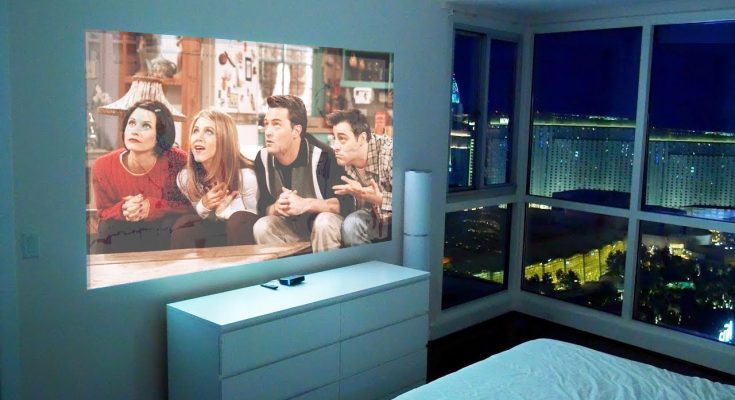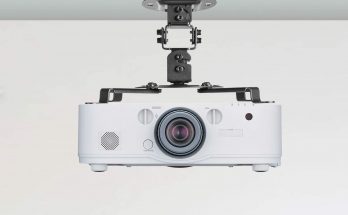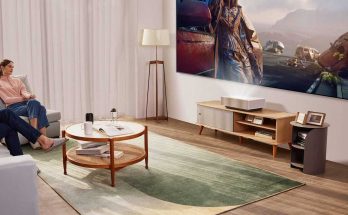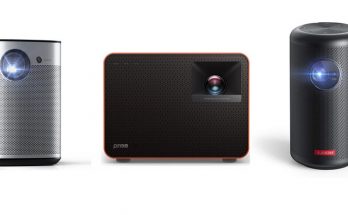Projection systems vary widely in size, price, features, and quality. Some home theater projectors are tiny, portable devices that plug directly into your TV and display an image via HDMI cable. Others are large, stand-alone models that require an external power source. Some project only video, while others also provide audio output. And some project both video and sound, while others are strictly silent. The best projector reviews include information about resolution, color accuracy, screen size, and how easy they are to set up and use.
Each type of projector has its own set of pros and cons. For example, if you’re looking for a projection system for a traditional movie theater experience, then you’d want one that offers high brightness levels and low glare. On the other hand, if you’re planning to replace a living room TV with a big screen, you might want something that doesn’t produce too much heat. And when you’re playing games, you probably don’t need an extremely bright image.
The purpose? You need to match the features of your home projector to the applications you wish to use them for. Here’s how you can figure out Best Projector For Bedroom to buy.
Quick Comparison
Contents
- Best Projector For Bedroom 2022
- Best Portable Smart TV: Epson EpiqVision Mini EF12 Smart Streaming Laser Projector
- Best Ultra Short Throw 4K Projector (With Android TV): Xgimi Aura 4K Ultra Short Throw Projector
- Best Ultra Short Throw 4K Projector (With Bundled Screen): Epson EpiqVision Ultra LS500 4K Pro-UHD Laser Projection TV
- Best Ultra Short Throw 4K Projector (for Color Accuracy): Optoma CinemaX P2
- Best Projector for Gaming and Home Theater: BenQ HT2150ST
- Best Semi-Portable 4K Projector: ViewSonic X10-4KE
- Best Mini Projector With 4K Input: Anker Nebula Solar Portable Projector
- Best Outdoor Movie Projector: Anker Nebula Mars II Pro
- Best Palmtop Movie Projector: Kodak Luma 350 Portable Smart Projector
- How to choose a projector for bedroom?
- FAQs
Best Projector For Bedroom 2022
The Epson EpiQ Vision Mini EF12 is a miniaturized version of an ordinary projection system. It has a long-lasting LED lamp, Android TV, Google play store apps and games, and good sound quality.
The Epson EpiQ Vision Mini EF12 is a miniaturized version of an ordinary projection system. It has a long-lasting LED lamp, Android TV, Google play store apps and games, and good sound quality.
Some detail product
- Stunning Picture Quality up to 150" — Delivers an immersive viewing experience for TV shows, sporting events, gaming and movies by accepting content up to 4K – for an amazing Full-HD HDR picture.
- Epson MicroLaser Array Technology — Unique multi-array laser diode technology produces an exceptional level of brightness while significantly enhancing the black density.
- True 3-Chip Projector Design — Advanced 3LCD technology displays 100% of the RGB color signal for every frame. This allows for outstanding color accuracy while maintaining excellent color brightness, without any distracting “rainbowing” or “color brightness” issues seen with other projection technologies.
- Long-lived laser-phosphor light source
- It has native 1080p resolution; it can support 4K UHD (3840 by 2160) input and HDR.
- A three-chips LCD engine (3LCDE) for equal colors and whites and no rainbow artifacts
- Integrated Android TV
- Two HDMI ports and Wi-Fi
- Impressive audio options
- No 3D support
- Only moderate brightness
The Xgimi Aura offers sharper pictures and better audio quality than most of its competitors. It has the potential to be one of the best cameras available.
Some product details
- Harman Kardon Sound: Two tweeters and two woofers at 15W each paired with DTS HD and Dolby Audio emit premium room-filling surround sound.
- ANDROID TV 10.0: Simplified access to 5000+ apps powered by the latest Android TV OS and easily navigable via Google Assistant voice control.
- Ultra Short Throw Technology: Place AURA 11.7'' away from any wall and get a 120'' screen size. 8-point keystone correction and 4-point keystone correction lets you manually adjust the projected image for a better viewing experience.
- Fast switching pixels allows for a smoother transition between frames, which results in a better viewing experience.
- Ultra short throw (UST) - Fills up to a 150-in screen from inches away.
- Rated at 2,400 ANSI lumens
- Laser phosphor light sources last the life of the projectors they're used in.
- Excellent sound
- Fully integrated Android TV 10
- Full HD 3D support
- Few rainbow artifacts
- Doesn't hold shadows well
- There aren't many ways to tweak image quality.
With its LCD-based Epiq Vision Ultra LS500 projector, Epson has made a solid choice for anyone who wants quality images at a reasonable price. It features excellent color accuracy, bright output, and no rainbow artifacts.
Some product details
- Ultra-Short Throw Laser-Array Technology — A new type of laser projection that produces a stunning picture, while being just inches from the wall itself. No complex wiring or ceiling mount required.
- Incredibly Bright Picture — displays 4K HDR (3) content at an exceptional level of brightness of 4,000 lumens in color; for all-day viewing in virtually any lighting environment
- 4K PRO-UHD (2) Projection Technology — advanced processing for resolution enhancement, color and image processing, resulting in an exceptionally sharp picture
- A laser-phosphor light bulb rated at 4,000 ansi lumens
- Epson's PRO-UHD TV sets match the quality of true 4K resolution.
- Includes a 100-inch screen with ambient light rejections (ALRs).
- A three-chip LCD panel design means there won't be any rainbow effects when displaying
- Includes Netflix ap
- More expensive than competitors using DLP technology
- Not fully integrated into Android TV
- Dongle supports wireless connections only.
For a small projector, the Optima Cinema X P2 offers great color quality and contrast, as well excellent audio. However, you need to be aware of any issues with color when using it for an extended period of time.
Some product details
- PEACE OF MIND: The CinemaX P2 includes a 2-year parts and labor limited protection on the projector and a 5-year or 12,000 hour light source protection (whichever comes first)
- VOICE ASSISTANT COMPATIBLE: With the Alexa smart home and custom skills or Google Action, control your CinemaX P2 projector with intuitive voice control using Amazon Echo and Google Home devices
- 4K UHD plus HDR10: Enjoy a high-quality, cinematic home theater experience with 4K Ultra HD, HDR10 technology and an incredible 2,000,000:1 contrast ratio
- Can fill an 85–120 inch display from inches away
- Using TI's XPR pixel shifter technology, you can get 4K resolution from
- Top-tier out-of-box color accuracy
- A color management software for calibrating monitors
- It's bright enough for a medium-sized to large living room with ambient lighting.
- Laser-phosphor light source
- Integrated streaming isn't worth considering when there's an HDMI dongles available for less than $20.
- You need to use at least two HDMI ports for 4K video content with HDR.
- More prone to rainbow effects than most U.S.T. DLP projector models
BenQ's HT2140ST does swimmingly for gaming and home theater. It has a minimal lag, giving players an important advantage when playing games. Its solid color accuracy, contrast, and black levels excel for watching movies in a darkened living space.
Some product details
- INDUSTRY LEADING WARRANTY : 3-year limited parts and labor coverage makes you rest easy that our us-based customer service team is here when you need it
- DLP TECHNOLOGY: DLP is the leading technology used in 90% of the world’s cinemas and 100% of digital IMAX theaters. You will experience a longer lasting, slimmer design, sharper and crisper image in BenQ projector
- FLEXIBLE INSTALLATION: Vertical keystone correction and a 1. 2x zoom allows easy installation
- Good color accuracy and good image quality at an affordable price
- A short-throwing lens provides a large image from close to the display.
- A low input latency means faster reaction times for game players.
- There is no way to increase the maximum input resolution beyond the native 1080 pixels wide.
- No support for HDR
With 4K Ultra HD resolution, HDR (High Dynamic Range), built-in streaming, and an excellent audio speaker, the ViewSonic X10–4KE is both ultra-portable and long-lasting.
Some product details
- VERSATILE SETUP: Projector can just as easily be mounted to the ceiling as it can be placed on a media stand
- PREMIUM AUDIO: Built-in Dual Harman Kardon Bluetooth speakers deliver room-filling audio
- PORTABLE DESIGN: An easy carry handle and short throw lens allows for big-screen projection in any room, indoors or out
- Long-lived LED light source
- Using TI's XPR fast switching technology, 4K UHD (3840x2160 pixels) video at 30 frames
- HDR10 support
- A built-in handle makes carrying easier.
- Notably high-volume, high-quality audio
- Integrated streaming, Android operating system, and smart home functions
- It seems brighter than the listed 2,400 LED lumen rating.
- Out-of- the-blue color accuracy is somewhat off.
- Shadow details are often disappointing when viewed at low light levels.
With its 1080p display, 4K/HDR support, built-in Android television, and decent brightness, the Anker Nebula Solar Portable is an excellent choice if you're looking for a portable projector. Its color accuracy isn't perfect, though.
Some product details
- Easy to Adjust: Leave that heavy tripod at home. Use Solar Portable 1080p projector’s built-in stand to adjust the angle of projection by up to 13 degrees.
- No Wires, No Limits: With Solar Portable 1080p projector’s built-in rechargeable battery, you can recreate the sights and sounds of the cinema anywhere you want. Get up to 3 hours of power on a single charge—more than enough to mini-binge your favorite TV series.
- Cinematic Visuals: Experience up to 120 inches of awesome 1080p entertainment. With HDR10 and 400 ANSI lumens also included, everything you watch and play is packed full of rich detail and color.(Recommended for use in dimmer environments.)
- It has a 1,920 by 1,080 native resolution; it accepts 4K video inputs.
- Supports HDR (High Dynamic Range) and copy protection (Content Protection for Recordable Media) used by 4K Ultra HD discs
- Android TV 9 and Wi-Fi built in
- Rated for up to three hours in Battery (Standby) or one hour in Normal operation.
- Capable autofocus
- Color accuracy is off by just enough to notice
- It doesn't improve image quality when using HDR images.
The Anker Nebula Mars II Mini Projector has good brightness, resolution and image quality for a small projector. It’s best for at-the-couch viewing, but not as portable as some of the competition.
Some product details
- Expand Your Entertainment: Plug and play your favorite HDMI and USB 2.0 devices, including laptops, PlayStation 4, Xbox One, Nintendo Switch, and more.
- NOTE: Copyrighted content from Hulu, Netflix, and similar services CANNOT be mirrored or screencast. Download and use the apps directly through Mars to view copyrighted content from these providers. Chromecast is not supported. For peak performance, please update to the latest firmware.
- All Your Favorites: Watch YouTube, Netflix, and more with Android 7.1 for hours of awesome content on your portable projector.
- Great color accuracy for its size
- Robust audio for a small device
- Built-in battery lasts up to 4 hours
- Accommodates any streaming stick
- One HDMI port, no other input options
- You can't adjust image settings.
The Kodak LUMA 350 Portable Smart Projector has a built-in Android operating system and a large screen size. It works well when used for displaying images, but its video quality isn't good enough for serious viewing.
Some product details
- THE PREMIER CHOICE FOR DLP PROJECTION | Portable Smart Projector Utilizes Breakthrough Digital Light Processing Technology to Render HD Video & Imaging w/ Stunning Color, Clarity &LED-Lumen Brightness | Massive Displays Up to 150” | Use With the iOS Luma 350 App for Intuitive Wireless Access
- COMPATIBILITY ACROSS ALL SMART DEVICES | Turn Your Phone Into a Remote| Discover the Ultimate All-Inclusive Multimedia Experience w/ Onboard Wi-Fi, Bluetooth, Screen Mirroring, HDMI & USB for Phone, Laptop, Tablet, Streaming through downloaded Apps, Blu-Ray, Consoles & More. Note: The remote can only turn off the projector.
- ADVANCED ANDROID 6.0 & iOS INTERFACE | Download Apps, Browse the Internet & Access Other Exciting Content Directly on the Projector | Device Features Easy-to-Use Light-Up Touch Controls, Manual Focus, Audio Output & Remote Control |Connect your Android or use the iOS Luma App for Even More Options
- Android 6 allows you to download and install new applications.
- Lightweight and portable
- Includes remote control, built-in battery
- Projecting a good-sized picture for its brightness
- Above-par photo quality
- So-so video quality
- Mere one-year warranty
- Limited controls on projector itself
How to choose a projector for bedroom?
Home theater projector is an obvious choice for home entertainment purposes, but not all home theater projectors are good options for game playing. Some home theater projectors are, and even some Business projectors include a Game Mode in their Menus. In perfect symmetry, some models, mainly from Benq and Optoma, are labeled as “game” projectors but are just as useful for other home entertainment purposes.
The biggest issue for playing games on a large TV is input latency, which is the amount of time in milliseconds (ms), measured from the moment an image is displayed on the television until the moment your controller receives the signal that tells it what to do. Some televisions have very low latency, so they’re perfectly acceptable for gaming. Other televisions have much higher latency, and they’re not suitable for gaming. Most of today’s high-end televisions fall into the latter category. They may have lower-resolution screens, but they have much shorter latency periods.
For most people, a lag time between 15 and 20 milliseconds is acceptable. However, if you’re looking for the best gaming experience, you may want to consider a monitor with a shorter lag time.
For any particular projector, the input lag depends on the display mode (e.g., HDTV vs. SDTV) and the refresh rates (i.e., 60 Hz vs. 50 Hz). However, the only lag that matters for your purposes is the one associated with the display mode and refresh rates that you intend to use.
A good way to improve image quality is by using a projector with a fast response time. The faster you can detect shadows, the better you’ll be able to recognize when someone sneaks up behind you or spots something interesting.
Many projectors come with a “Gaming” mode that turns off some of the projector’s processing functions and adjusts the brightness and contrast levels to suit different types of games.
FAQs
There are several key specifications and feature requirements to consider when buying a new projection system. These include the screen size, the display type, the number of projectors needed, the supported formats, the required input devices, and the desired image quality. Let’s take a look at these topics one by one.
What Resolution Do I Need?
Before 4K resolutions hit the market, the highest-quality projection systems were limited to 1080p because they used imaging devices with lower pixel counts than today’s best digital projectors.
Native 4K projectors cost thousands of dollars, but cheaper ones use 1,920-x-1080 screens combined with pixel shift technology. These cheap projectors work by breaking 4K pictures into multiple sets of 1.920 x 1080p and then moving the pixel positions slightly so each picture has more resolution than the chip itself.
Most such models use 4 sets of 1920×1080 to display a 3840×2160 resolution. However, most Epson printers use just two sets of 1920×1080 for displaying 3840×2160 images. Thanks to the limitations of human vision, the 3840×2160 picture displayed by an Epson printer looks exactly like a 3840×2180 picture would look if viewed at a distance of approximately one meter (39 inches).
Most would agree that there isn’t any real difference between native 4K displays and pixel-shifted ones.
Do I need HDR?
HDR (High Dynamic Range) can make images brighter than they normally would be, allowing them to show details that were previously lost in shadows or highlights. However, HDR does not necessarily mean higher resolution. For example, an 8K TV might offer 10 times the detail of a 1080p display, but if the HDR version of the same picture only shows half the contrast ratio, then it won’t really be any clearer. To get around this problem, HDR displays often include a feature called HLG (Hybrid Log Gamma), which allows them to reproduce colors closer to what our eyes see. But, again, HLG doesn’t increase the number of pixels on the screen, so it won’t improve the resolution of your photos or videos.
If you want to know which HDR formats are available, you need to look into them. For example, HDR10 is the most popular format for projector use, and HLG is gaining traction. However, if you’re looking for support from online streaming services, Dolby Vision might be an option.
Which kind of light source do I want?
Projectors using traditional bulbs tend to be less expensive than projectors using LED lights or laser beams, but they’re not cheap. You may need to purchase replacement bulbs every few years. When shopping for projectors, consider adding in the price of replacement bulbs to the final total.
In order to make your website easier to read, we’ve made changes to the font size of our pages. We hope you find these changes useful. Thank you.
Which imaging technology do I want?
When choosing between LCD, DLP, and LCoS projectors, the choice comes down to how much money you’re willing to spend. While LCD and LCoS project display panels are typically cheaper than DLP displays, they also require additional components such as backlights and color filters. On top of that, LCDs and LCoSs are generally smaller than DLP projectors, so if you plan on mounting your projector on a wall, you’ll probably need to make room for extra space around the display panel. Finally, LCDs and LCOs do not produce as bright images as DLP projectors. In short, LCDs and LCPs are great for low-cost projects, but if you’re planning on spending any significant amount of money on your projector, go with a DLP.
Most single-projection displays use a single CCD (charge-coupled device) sensor, although some dual-sensor systems exist. Single-CCD projectors generally produce much better images than multi-CCD models because they do not suffer from cross-talk between pixels. Cross talk causes color fringing and moiré patterns. In addition, single-CCD projectors typically cost less than multi-CCD units. However, these advantages come at the expense of image quality. Single-CCD projects also exhibit ghosting effects, where objects move through the display as the projection changes. These problems are exacerbated by higher brightness levels.
What Brightness Level Should I Look For?
Specifications are not useful for determining whether a projector is bright enough for the room and the screen size and position that you’ll be using it for. They may even mislead you into thinking that the projector isn’t bright enough for the task at hand.
When buying a new projector, read reviews carefully to see if they mention the maximum screen size that the projector can project an acceptable picture onto without clipping (black bars). Also, pay close attention to any discussion of HDR brightness versus SDR brightness; if the projector has good HDR brightness but not good SDR brightness, choose another one.
When considering the brightness of an LCD panel, you must take into account both the LCD panel itself and any attached projectors. If you’re using two separate LCD panels and projectors, they may be working together to increase or decrease the overall brightness of your presentation.
So, which projector should I buy?
Here are our current top picks for best projectors: They vary greatly in specifics and are targeted towards different types of homes, but they share one thing in common: they received high marks in our reviews and we’ve included some helpful hints for choosing the right type of projection screens.
Useful guide Projector: Several Things You Need To Know Before Buying One






















